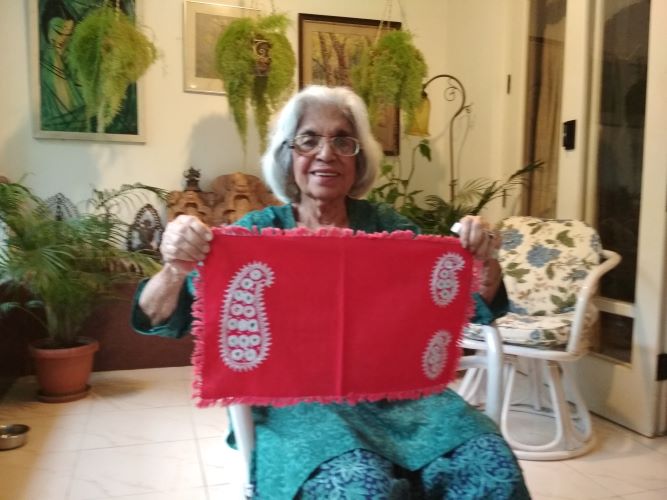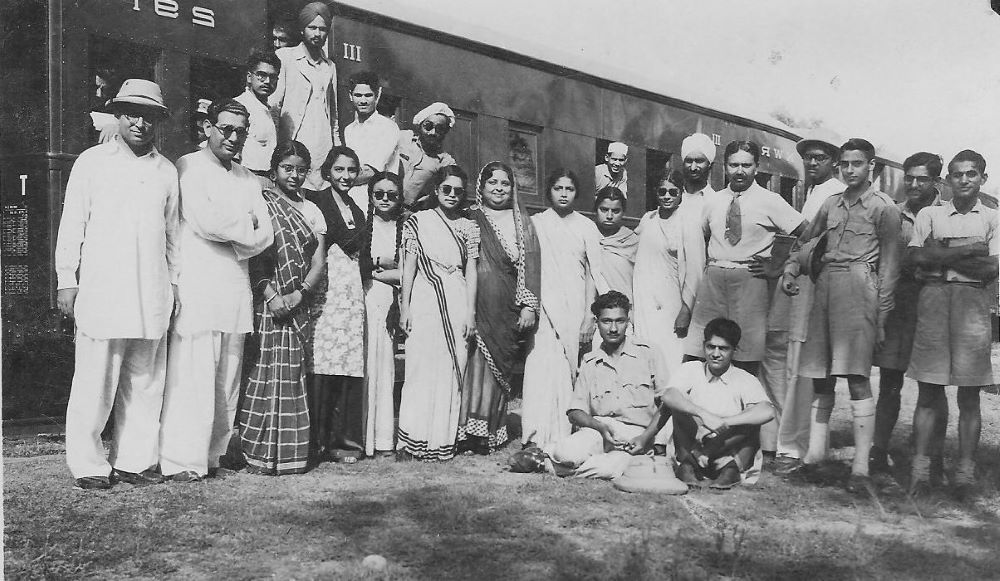
Yesterday, 3 Jan 2024, would have been Hira’s 101st birthday – but she passed away just a few days before.
Saaz Aggarwal
I met her in August 2017, and very much enjoyed interviewing her. One of her most striking memories was of the day in March 1931, when Bhagat Singh was executed, and all of Sindh went into mourning. Hira was a schoolgirl in Larkana where her father, Kishinchand Shivdasani, was Executive Engineer. A procession was passing by her house, and she ran out to join it along with neighbors from across the road. People had come out to protest, wearing white clothes stained with blood, a sight Hira never forgot. They chanted and sang songs of mourning to bid farewell to the great hero Bhagat Singh. As they walked through long roads and the bazaar, more and more joined the procession.
Here is more of what she told me, under the heading “A fulfilling life” in my book The Amils of Sindh.
Kishinchand Shivdasani was executive engineer of Larkana district, and lived with his wife Silwanti and children Sundar, Hira, Damyanti and Gulab in Larkana town. Silwanti often tried to get Hira to read the Japsahib but Hira would reply, “My father does not believe in religion and neither do I.” One day, Silwanti made Hira an offer she could not refuse. If Hira read the Japsahib, she would get one rupee for each pauri she memorized. So Hira took the book and sat down with it and next day came to her mother and recited all thirty-three pauris, and Silwanti had no choice but to quietly hand over thirty-three rupees.
One of her most striking memories was of the day in March 1931, when Bhagat Singh was executed, and all of Sindh went into mourning.
Kishinchand was one of nine brothers. The eldest, Gopaldas, was a zamindar who looked after the family lands. Next were Dr Kalyandas, Civil Surgeon, and Kewalram, Sessions Judge. Then came Ghanshyamdas and Vishindas, freedom fighters. Ghanshyamdas was a professor and Vishindas, educated in Paris, an intellectual known for his love of the good life. Both spent years in jail during the Quit India movement.
The seventh brother, Shivram, had a toy shop in Saddar Bazaar. He and his wife Lali had a beautiful daughter, Sadhana, who became one of the most famous film stars of her time. There were other famous film stars in the family.
Kalyandas’s son Hari, a well-known actor himself, was married to Barbara whose mother was English and father was Thakur Thadani, a senior judge. Their daughter Babita and her daughters Karishma and Kareena Kapoor have also been famous film stars. Younger to Shivram was Jaichand, also a zamindar, and the youngest brother, Papu, was an intellectual.
The family home in Hyderabad was a long, grand building opposite the Hirabad Post Office, with rooms on the ground and first floor. Jethanand Shivdasani, their father, was a zamindar with a big landholding in Nawabshah. Hira remembers one holiday when there were eighty people living comfortably in the house. There were two cooks and at breakfast time, one made the koki and the other made tea and everyone stood in a queue to get their share.
The Bhutto family, who were from Larkana, were good friends of Hira’s parents. Begum Bhutto was in purdah but would come to meet Silwanti. Hira remembers being invited for her son Zulfiqar’s circumcision ceremony – he would have been four or five years old and she herself, seven or eight, clearly remembers him lying on the carpet and howling in pain.
One year, on holiday in Karachi with her mama Gangaram Chandiramani and his wife Saraswati, Hira met her mami’s brother Krishna Kripalani. He lived and worked in Shantiniketan, and had come to Sindh with his wife Nandita, who happened to be Rabindranath Tagore’s granddaughter. Hira and her friends became very close to Nandita, and began to call her ‘Bhuridi’, which means elder sister in Bengali. When she suggested that they come along and study in Shantiniketan, they agreed.
A group of about seventeen Amil girls, including Hira’s sister Sundar; their friends Lo and her younger sister, the charming Gopi Mukhi; Krishna’s niece Mohini Chandiramani; Hira Lakhani and others.
When the Amil girls arrived in Shantiniketan, they were clothed as at home – in dresses. Word went around that the new group of students were Anglo Indians! Next day they went to buy saris. That Sunday, and every Sunday for the rest of her two years in Shantiniketan, Hira and her friends had lunch at Tagore’s home.
The girls were homesick for their first few days, and it took some time to get used to Bengali food but it soon began to feel like home and Hira can still speak Bengali, even today. She looks back on her opportunity to study at Shantiniketan as the most beautiful thing that ever happened to her. It was a free environment with no restrictions or gossip and the quality of teaching staff was so good that her Physics teacher was an excellent sitar player and her Chemistry teacher sang beautifully – “everybody at Shantiniketan could sing,” she remembers wistfully. And everybody walked barefoot – the pathways of Shantiniketan’s iconic red earth were gentle on the feet.

When the Amil girls arrived in Shantiniketan, they were clothed as at home – in dresses. Word went around that the new group of students were Anglo Indians! Next day they went to buy saris.
The two years of Inter Science passed quickly. Sundar stayed on and completed her graduation but Shantiniketan had no further education in science so in 1940 Hira moved to Lahore to stay with her mama and mami, Wadhumal and Jamna Bhojwani.
Seth Wadhumal was from the Bhojwani family, descended from Seth Naomal; he was Seth Gidumal’s brother. The Bhojwanis were in the moneylending business and very well off; Karachi Club had a big hall which had been donated by Wadhumal. However, in the stock market crash of 1929, Wadhumal lost all his money. He left Karachi, settled in Lahore with his family and took up a car dealership. The children, Dayaram, Kishin, Valiram and Thakur, and their sister Muli, were still in school. As they grew up, the boys began working as car salesmen too.
Hira did BSc Honors and then MSc at Government College, Lahore. Nature took its course and she and Thakur fell in love and got married in 1943. In 1946, she began working towards her PhD, but as Partition approached, things became uncertain. Thakur went to Bombay on an assignment for a Lahore businessman and took to the city with delight. One day, he came across a Gujarati gentleman who offered him a job in his company. It looked very interesting, so Thakur agreed to join. However, he wanted to prove his worth before he claimed the kind of salary he expected and offered to work for six months without pay. At the end of six months, when the promoters of the company offered him Rs800 per month, a princely sum for the time, he sent for his wife.
Hira, living in Colaba, began visiting the refugee camps in the distant suburbs to help with rehabilitation.
Hira sold their car and furniture and transferred the wedding gift of Rs10000 she had received from her parents through the Imperial Bank in Lahore to the Imperial Bank in Bombay. This enabled her to pay pagri for a two-bedroom flat in Colaba and still have quite a lot left over. When Partition took place, Hira’s parents came quite easily from Larkana to Karachi and then by sea to Bombay. Lahore was facing much more violence and danger. Thakur’s brother Kishin had just returned home from England and was able to bring his parents safely to Bombay. Gradually, the whole family came to Bombay. Then Muli, who had been a school teacher in Karachi, was deputed by the new Government of India to go back and live in Pakistan to help with the process of tracing non-Muslim women who had been abducted and restoring them to their families. Muli continued doing this work for about a year but the project had heartrending results. Many of the women were rejected by their husbands because they had lived with Muslims.
Hira, living in Colaba, began visiting the refugee camps in the distant suburbs to help with rehabilitation. She saw familiar faces from Larkana and women sometimes came up to her with a bangle or chain, the last little trinket they had somehow saved and were now trying to sell to feed their children. It upset Hira to think that they were ready to trade in their last piece of security for food. She put out word with her neighbors that she was starting on a project and got them to agree to support it. She bought material for skirts, blouses, purses, table mats, napkins and other things, gave the women designs and sent them home to start sewing and embroidering. Her friends told their friends and word spread. People bought, more and more refugee women took to earning money this way, and the scale of operations kept growing until Hira had about three hundred women making the things. She hired ten agents and put about thirty workers under each one to sell them door to door. Word spread and a time came when the American embassy started sending guests to buy. As time went by, Hira gradually reduced her involvement and began to work with her husband in their own company, Bright Brothers.
(There’s more about that in another section of the book The Amils of Sindh by Saaz Aggarwal)
Read author’s other article: Haridwar – Records of Sindhi Pilgrims’ Travel and Worship
____________________
 Saaz Aggarwal is an independent researcher, writer and artist based in Pune, India. Her body of writing includes biographies, translations, critical reviews and humor columns. Her books are in university libraries around the world, and much of her research contribution in the field of Sindh studies is easily accessible online. Her 2012 Sindh: Stories from a Vanished Homeland is an acknowledged classic. With an MSc from Mumbai University in 1982, Saaz taught undergraduate Mathematics at Ruparel College, Mumbai, for three years. She was appointed features editor at Times of India, Mumbai, in 1989.
Saaz Aggarwal is an independent researcher, writer and artist based in Pune, India. Her body of writing includes biographies, translations, critical reviews and humor columns. Her books are in university libraries around the world, and much of her research contribution in the field of Sindh studies is easily accessible online. Her 2012 Sindh: Stories from a Vanished Homeland is an acknowledged classic. With an MSc from Mumbai University in 1982, Saaz taught undergraduate Mathematics at Ruparel College, Mumbai, for three years. She was appointed features editor at Times of India, Mumbai, in 1989.
Courtesy: Saaz Aggarwal | Sindh Stories (Posted on January 4, 2024)